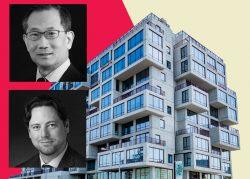 Rent stabilization: dysfunctional by design
Rent stabilization: dysfunctional by design
Trending
Private equity giant Carlyle’s latest big play: Small Brooklyn buildings
Firm quietly builds $500M portfolio of modest apartment buildings

Flying under the radar, the Carlyle Group has stitched together a half-billion-dollar portfolio of small apartment buildings in Brooklyn.
Over the past year, the private equity giant has bought more than 130 of them in hot neighborhoods such as Bushwick, Bedford-Stuyvesant, Park Slope and Cobble Hill, according to sources and an analysis of property records by The Real Deal.
It’s one of Wall Street’s biggest moves into the realm of mom-and-pop landlords and an unusual approach for a company that raised an $8 billion real estate fund in December.
In many instances, Carlyle is buying these buildings one at a time, writing the kinds of $2 million or $3 million checks common to the small investors who dominate the space.
“Generally these owners are small to mid-sized operators that bite off what they can chew,” said Michael Tortorici of commercial brokerage Ariel Property Advisors. “It’s not often you see people looking to amass massive portfolios.”
A spokesperson for Carlyle declined to comment. People familiar with the firm’s strategy said it’s targeting a specific type of building that falls into the city’s 2A/2B tax designation, which limits increases on real estate taxes to no more than 8 percent a year. These properties have no more than 10 units and tend to be mostly free-market, avoiding the severe restrictions imposed on owners by the 2019 rent stabilization law.
And because they lack such amenities as doormen and elevators, the buildings have relatively low operating costs. Moreover, the end of the 421a break will limit future competition from new rental buildings.
That type of high-margin, predictable investment is becoming increasingly attractive to institutional players willing to endure the grunt work of building large portfolios one small building at a time, according to Rich Velotta of commercial brokerage Raven Property Advisors.
Besides, he said, there’s no easy alternative.
“If you’re someone like Carlyle and you’re looking to put out quite a bit of capital, it’s difficult in the more supply-constrained markets of prime Brooklyn and Manhattan to find large-scale multifamily that isn’t rent-stabilized,” said Velotta. “It’s probably borne out of a function of necessity.”
Going small
Such smaller buildings have traditionally been stepping stones for rookie landlords.
“These are often kind of an entry point for new investors,” Tortorici said. “They’re not too big financially or operationally, so people look to fix them and then sell and move on up.”
Carlyle’s U.S. real estate head Jason Hart and principal Wonjoong Kim made a big move into the space in December, when the firm teamed up with landlord Greenbrook Partners on a portfolio of about 45 buildings.
Read more
 Rent stabilization: dysfunctional by design
Rent stabilization: dysfunctional by design
 For $85M, Carlyle nabs another LIC resi building
For $85M, Carlyle nabs another LIC resi building
Greenbrook, led by Greg Fournier, had recently gone on a Brooklyn buying spree but was drawing some unwanted attention. Tenants at Greenbrook-owned buildings in Park Slope cried foul last year when their landlord declined to renew their leases on free-market apartments.

Brad Lander has spoken out against Carlyle’s partner, Greenbrook. (Getty)
The move came as Wall Street was drawing heat for buying up single-family homes, and then-City Council member Brad Lander and U.S. Senate Majority Leader Charles Schumer publicly denounced Greenbrook.
Lander, now the city’s comptroller, said he hasn’t heard of any similar complaints at Carlyle-owned buildings. But he did object to the encroachment of private equity investors “which focus on short-term profit-making at the expense of long-term tenants … accelerating the crisis of housing affordability and stability across our city” and furthered his call for “good cause eviction.”
Greenbrook did not respond to requests for comment. Immediately following the initial negative publicity, the firm had said it would talk to tenants about lease renewals. (This May, Mother Jones published an extensive investigation on the company, documenting tenant experiences at its building as part of a series called “How Private Equity Looted America.” The publication identified ties to Carlyle on three-dozen of its properties, but TRD’s analysis reveals a far bigger bet.)
After partnering with Fournier, Carlyle went around buying buildings on its own across Brooklyn and picked up a few in Queens as well. This month, the firm landed a $500 million mortgage from Invesco secured by the properties.
While Carlyle may be the biggest name to make a play for 2A/2B buildings, it’s not the first. And investors are paying more attention to the space.
Highpoint Property Group, led by former Naftali Group executive Drew Popkin, has been collecting these small buildings since 2017.
Highpoint recently put on the market a portfolio of 20 buildings with 146 units in Chelsea, the East Village and Cobble Hill/Brooklyn Heights with an asking price approaching $300 million, according to a source.
Marketing materials from Meridian Investment Sales, which is handling the sale, highlight the buildings’ upside and their “unique protections afforded only by NYC tax class 2A/2B properties.”
Protection premium
Carlyle appears more willing to grind out lesser deals than its peers, who tend to go big.
Blackstone, for example, paid $930 million in June for the 76-story 8 Spruce Street rental tower in Manhattan, and KKR has spent about $1 billion over the past two years buying up relatively large, new buildings in Brooklyn with the Wrublin family’s Dalan Management.
And while Carlyle in March closed a deal to buy an 18 million-square-foot portfolio of net leased properties from iStar for $3 billion, its deals in New York have been more modest – except when looked at in aggregate.
The company in October paid $34 million to buy a 40-unit loft building in Clinton Hill. In November, it bought a new 175-unit rental building in Queens at 22-22 Jackson Avenue for $85 million.
Carlyle plans to build a three-story, self-storage facility in Crown Heights on a property it bought for $13 million in 2020.
It’s not clear what the company has in store for its tax-protected portfolio. Some observers speculated the company could be employing the typical private-equity roll-up model of assembling a portfolio to sell down the line.
Blackstone and KKR have also launched non-listed REITs that allow retail investors to buy into their portfolios.
Shimon Shkury, president of Ariel Property Advisors, said investor interest for the 2A/2B buildings is growing.
“Because they’re tax class–protected, there is a premium investors are willing to pay,” he said. “You know your taxes are going to stay stable for the foreseeable future, and in an inflationary environment like today, they could also be considered inflation hedges.”




